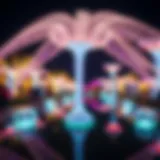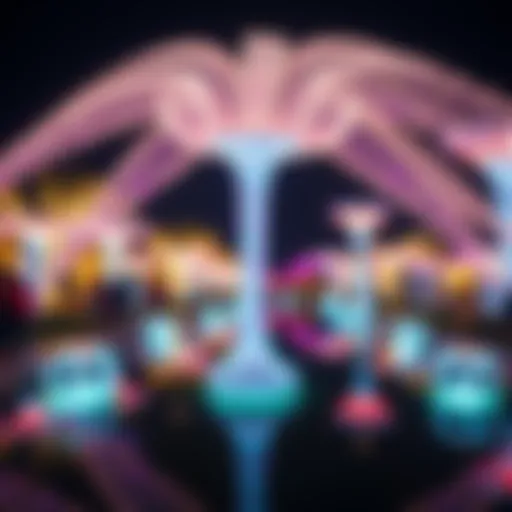Ras Al Khor Flamingos: Nature Meets Urban Life in Dubai
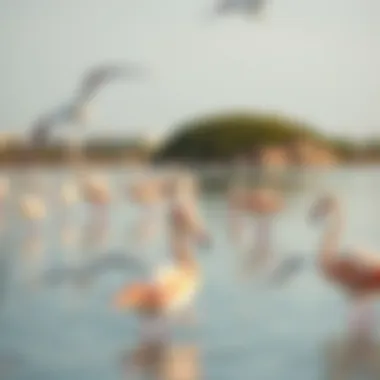
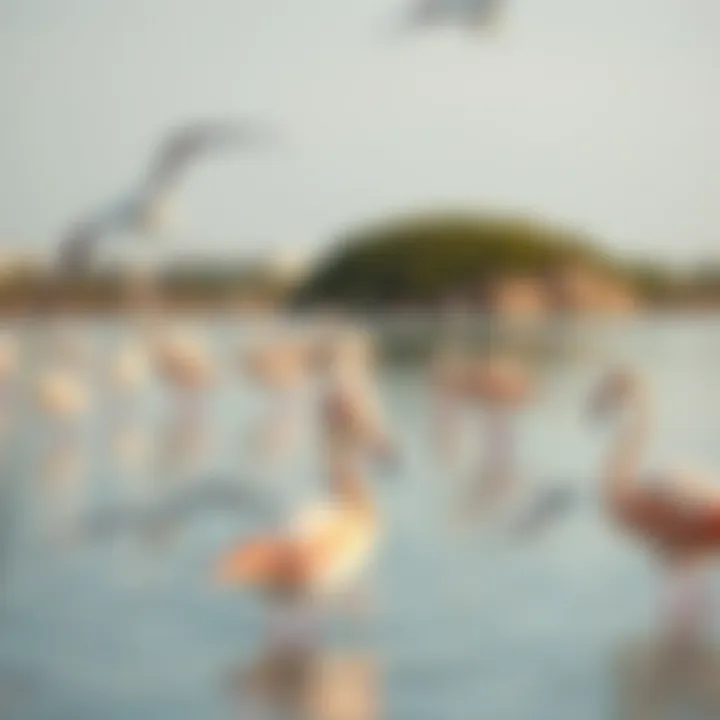
Intro
Ras Al Khor Wildlife Sanctuary is not merely a plot of land teeming with wildlife; it's a living testament to how nature can coexist alongside the urban sprawl of Dubai. Known for its impressive flamingo population, the sanctuary serves as a refuge for migratory birds, all while being surrounded by a burgeoning metropolis. Each year, thousands of visitors flock here, eager to witness this remarkable avian spectacle, especially during the winter months when the flamingos are in full display.
For homeowners and investors, understanding this unique intersection of nature and urban living holds significant promise. As the real estate landscape progressively evolves, the appeal of properties adjacent to natural spaces becomes more pronounced. Living near Ras Al Khor could offer not just a scenic view but also a potential increase in property value, as buyers grow increasingly conscious of their environment.
In this article, we shall explore the various facets of this fascinating locale—from the ecological significance of the sanctuary to the economic implications for real estate investors. We’ll further delve into key market insights and practical tips for those looking to buy or invest in Dubai's dynamic property landscape.
Preface to Ras Al Khor
Ras Al Khor Wildlife Sanctuary sits like a well-guarded secret in the bustling metropolis of Dubai, striking a delicate balance between the rapid urban development and the serenity of nature. This expansive area, located at the confluence of land and sea, provides a vital habitat for various wildlife species, particularly the vibrant flamingos that have become synonymous with the sanctuary. As we explore Ras Al Khor, one cannot overlook the intricate interplay of nature and urban life that defines this region. This section emphasizes the geographical uniqueness and significance of the sanctuary, offering insights into its role as a sanctuary for wildlife amid a backdrop of towering skyscrapers and luxury developments.
Geographical Overview
Ras Al Khor is situated along the coast of the Arabian Gulf, where the waters of the creek intricately weave into the urban landscape of Dubai. Covering a remarkable area of approximately 6.2 square kilometers, the sanctuary is characterized by its salt flats, mangroves, and mudflats that support a diversity of ecosystem dynamics. The location of Ras Al Khor, just a stone’s throw away from bustling commercial centers like Downtown Dubai and Dubai International Airport, makes it easily accessible while providing a stark contrast to the surrounding urban sprawl.
The unique positioning of the sanctuary serves multiple purposes; it functions as a natural buffer against coastal erosion, while simultaneously offering a rich environment for biodiversity. The presence of tidal marshes and intertidal zones creates a thriving aquatic ecosystem, attracting migratory birds and other wildlife throughout the year. Importantly, this geographical feature not only enhances the ecological landscape but also elevates the area's appeal to property buyers and investors considering living close to nature amidst the urban setting.
Significance of the Sanctuary
The sanctuary's significance extends beyond mere geography; it serves as a vital refuge for both wildlife and urban dwellers seeking a slice of tranquility. Ras Al Khor plays a crucial role in sustaining a biodiverse environment, acting as a breeding ground for numerous bird species, including the iconic flamingo. This place is an environmental gem where local and migratory birds find shelter, food, and breeding grounds, ensuring the survival of various species in an age where natural habitats are increasingly compromised.
The sanctuary not only benefits the wildlife but also fosters a sense of community among residents. It presents an opportunity for eco-tourism, education, and engagement with nature. Positive interactions between visitors and the environment at Ras Al Khor encourage the public to appreciate the importance of ecology. Moreover, the sanctuary emerges as a potential hot spot for property investors in Dubai, who increasingly prioritize green spaces and nature-friendly surroundings for lifestyle development.
"Ras Al Khor serves not only as a sanctuary for wildlife but also as a vital component of urban life in Dubai, reminding us of the importance of preserving nature in our fast-paced world."
In summary, Ras Al Khor is a vital ecological reserve that merges seamlessly with Dubai's urban life. Its geographical features and ecological importance form the foundation for understanding the unique dynamics at play, a dance of flamingos against the backdrop of luxury developments. Emphasizing the sanctuary’s importance sets the stage for a more in-depth examination of flamingos and their role in this harmonious blend of nature and city life.
Flamingos in Ras Al Khor
The presence of flamingos in Ras Al Khor is not just a mere coincidence; it represents an intricate relationship between urban life and natural beauty. In a city famed for its towering skyscrapers and bustling economy, these elegant birds remind us of the lush beauty present in conservation areas amid urban sophistication. Knowing how these flamingos thrive in their habitat allows for a better understanding of the ecosystem and its importance, not just for them but for the community as a whole.
Species Overview
The greater flamingo, the primary species observed in Ras Al Khor, is renowned for its distinct pink plumage. This vibrant color derives from their diet, particularly from carotenoid-rich algae and small crustaceans found in the wetland habitats. An adult flamingo can stand over a meter tall and can weigh anywhere from 2.5 to 4 kilograms. Their long legs and neck help them wade in shallow waters, allowing them to reach the delicacies below.
Apart from their physical appearance, flamingos exhibit fascinating social structures. They are highly gregarious birds, often seen in large flocks that can number in the thousands, which enhances their safety from predators. The congregation also plays an essential role in their breeding and nurturing practices. In a world where many species face extinction, the flamingo stands out as a symbol of adaptability and resilience.
Life Cycle and Behavior
Flamingos are interesting creatures when it comes to their life cycle. Mating typically happens in the months of April and May. After courtship displays, they build nests of mud and pebbles where the female usually lays a single egg. Both parents take turns incubating the egg, showcasing a unique form of collaboration. Upon hatching, the chicks are initially gray and rely on their parents for food, primarily feeding on a mixture rich in nutrients given in the form of a special fluid.
As the chicks grow, they start to develop their feathers, transitioning from that dull gray into the striking hues that flamingos are celebrated for. This change doesn’t occur overnight; it takes them several years to achieve their full coloration, which can vary significantly based on their diet and habitat. Behaviorally, these birds are known for their elaborate courtship rituals, which include synchronized dancing and vocal displays, reinforcing social bonds within their groups.
Seasonal Patterns of Migration
Ras Al Khor’s wetland ecosystem attracts flamingos at specific times of the year. These seabirds embark on migratory journeys seeking warmer climates during winter months. Generally, they arrive in larger numbers between October and March, coinciding with the cool season in the region. This influx is critical for their survival as it allows them to access abundant food sources unavailable during the scorching summer months.
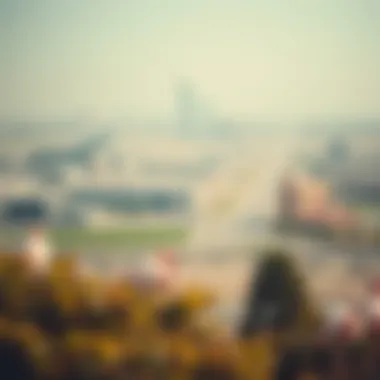
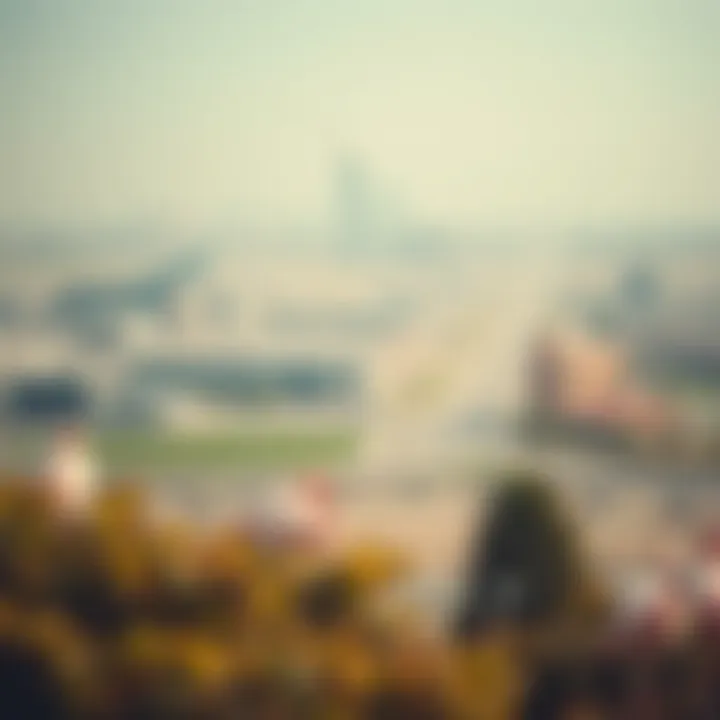
Notably, the migration patterns are remarkable. The flamingos aren't merely attracted by climate changes; they also follow the cyclical availability of their food sources. They adapt their feeding habits based on seasonal changes, making them icons of survival in varying conditions.
Understanding these patterns can be beneficial not only to nature enthusiasts but also to real estate investors interested in how urban development affects these migratory habits. The symbiotic relationship between the flamingos and the ecosystem serves as a crucial benchmark for ecological stability—something potential property buyers might want to consider in their investment strategies.
Ecological Importance of Wetlands
Wetlands like Ras Al Khor play a pivotal role in maintaining the ecological balance of the regions they inhabit. These unique ecosystems serve multiple functions that are not just beneficial to wildlife, but also to human communities nearby. Given the rapid urbanization taking place in Dubai, understanding the significance of these wetlands is crucial. Of particular note is their ability to act as a natural buffer against climate change while providing essential habitat for numerous species, including the iconic flamingos.
Role in Biodiversity
Wetlands are often considered biological hotspots, teeming with life. They host a myriad of flora and fauna that rely on these rich environments for survival. One key aspect is that they are breeding grounds for many aquatic species and migrants. Migratory birds, for example, rely on the shelter and food provided by wetlands during their long journeys. The variety of habitats within these areas—ranging from marshes to mudflats—makes them indispensable for supporting diverse species.
Such biodiversity isn't just significant in a 'warm fuzzy' sense. It has direct implications for potential real estate opportunities as well. Properties that are near biodiverse environments can fetch higher valuations. Buyers recognize that areas rich in life often see better environmental health and thus could lead to increased property values in the long haul.
Ecosystem Services Provided
Wetlands provide a suite of ecosystem services vital for urban centers like Dubai. Firstly, they act as natural water filters. The ability to trap sediments and absorb pollutants is not trivial; these services contribute directly to cleaner water entering the larger surroundings, benefiting both wildlife and humans. Furthermore, wetlands help mitigate flooding by absorbing excess rainfall and slowly releasing it, a crucial property in dense urban areas prone to waterlogging.
In terms of climate regulation, wetlands sequester carbon, which helps in mitigating climate change impacts. According to various studies, maintaining such natural spaces could potentially offset significant carbon emissions which, in turn, is attractive for environmentally conscious investors.
Developers and investors in the vicinity of Ras Al Khor should thus consider the long-term value these ecosystems provide. They don't just enhance nature; they improve the quality of life and the desirability of the surrounding areas.
"Wetlands are the kidneys of the landscape, filtering impurities as they store life-giving water and diversity."
Thus, knowing how careful preservation of wetlands can foster economic growth and support biodiversity should lead to a more interconnected approach to urban planning and conservation in Dubai. Investors who grasp this relationship can find opportunities that harmonize profitability with ecological awareness.
Conservation Efforts in Ras Al Khor
Conservation at Ras Al Khor Wildlife Sanctuary isn't just a whispering current among the reeds; it's a robust effort that reflects a harmony between nature and urban growth in Dubai. Situated at the city's crossroads, the sanctuary serves as an essential refuge for wildlife, especially the flamboyant flamingos. The stakes are high here, where the buzz of city life meets the need to protect the delicate ecosystems that grace the area. These conservation efforts are vital because they aim not only to safeguard the biodiversity present but also to instill a sense of responsibility in the community and potential investors about the environmental impact of urban development.
Management Initiatives
Management of conservation efforts at Ras Al Khor is no walk in the park; it involves strategic planning and hands-on activities to ensure the sanctuary's health. The Dubai Municipality leads initiatives that focus on creating and maintaining habitats suitable for the flamingos and other species. These initiatives include:
- Habitats Maintenance: Regular monitoring and rehabilitation of areas to provide optimal conditions for wildlife.
- Research Programs: Collaborations with academic institutions to study the habitats and the species within, resulting in better-informed policies and practices.
- Protected Areas: Designating specific regions as no-access zones to minimize human disturbance during critical life stages of wildlife, such as nesting or migration.
These measures reflect a commitment to preserving the ecological balance while allowing for the growth of urban developments that surround the sanctuary.
Community Involvement
The success of conservation in Ras Al Khor heavily leans on community engagement. The local populace, including schools and organizations, are encouraged to participate actively in efforts to safeguard wildlife. Initiatives like:
- Community Clean-Up Days: Residents come together to clean up the area, reducing pollution and enhancing the site's appeal.
- Awareness Campaigns: Ongoing educational programs aim to inform locals about the importance of the sanctuary, creating stewards who recognize the value of protecting the natural environment.
- Volunteering Opportunities: Groups are invited to assist in monitoring wildlife and participating in habitat restoration projects, turning conservation into a community-driven activity.
By forging ties with the community, conservation efforts turn into a shared responsibility, making local residents feel personally invested in the sanctuary's well-being.
Challenges Faced
Despite the commitment to conservation, challenges loom large over Ras Al Khor. Some of the key obstacles include:


- Urban Encroachment: Rapid urban development poses a significant threat to the sanctuary’s habitats, with increasing pressure to develop the land.
- Pollution: Runoff from urban areas can lead to contamination of water bodies within the sanctuary, affecting the health of wildlife.
- Climate Change: The impacts of climate change threaten not only the flamingos but also the delicate balance of the wetland ecosystem, leading to shifts in habitat conditions.
“Conservation in Ras Al Khor is not merely an environmental mandate; it is an urban necessity that demands balance and careful navigation.”
Flamingos and Real Estate Dynamics
The interaction between flamingos and the real estate landscape in Dubai presents a fascinating and intricate tapestry of nature meeting urban life. As the city pushes toward modernization, developers and planners must consider how their projects impact not only economic prospects but also local wildlife, notably these iconic wading birds. This consideration is not just ethical; it’s strategic. Understanding flamingos’ relationship with their habitat can offer valuable insights for investors and homeowners alike.
Impact on Property Values
The presence of a wildlife sanctuary, particularly one as renowned as Ras Al Khor, can significantly impact property values in the adjacent areas. Research has shown that homes located near green spaces and natural habitats often command higher prices. Here’s a breakdown of the reasons:
- Desirable Location: Properties near Ras Al Khor are seen as more attractive due to their proximity to nature. This is especially pertinent in a bustling metropolis like Dubai, where natural landscapes can feel scarce.
- Enhanced Lifestyle: Living near the flamingo sanctuary offers residents unique recreational opportunities—birdwatching, photography, and nature walks foster a wholesome lifestyle, which can be a potent selling point for real estate.
- Environmental Awareness: As sustainability becomes increasingly important, homes near wildlife sanctuaries can appeal to environmentally-conscious buyers. Such properties may be marketed highlighting a commitment to conservation, influencing the purchase decisions of buyers.
However, market fluctuations based on these factors can vary. Investors should keep a vigilant eye on trends and shifts in buyer preferences—what appeals now might change as public consciousness evolves.
Estate Development Near Natural Habitats
When it comes to estate development near natural habitats like Ras Al Khor, there is a careful balance to strike. On one hand, developers see the opportunity to create luxury living in scenic locations. On the other hand, there’s a responsibility to maintain the environmental integrity of these areas.
- Regulatory Framework: Development must comply with local regulations aimed at protecting the sanctuary. The UAE government has strict measures in place that ensure developments do not encroach on vital ecosystems.
- Innovative Solutions: Developers now explore eco-friendly construction practices. Buildings are designed to blend into the landscape, utilizing sustainable materials and energy-efficient technologies that leave a lighter footprint on the land.
- Community Integration: Projects that incorporate natural elements, such as parks or wildlife education centers, create a symbiosis between the urban environment and the sanctuary. This fosters a community ethos centered on conservation, enhancing the appeal for potential buyers.
"The relationship between flamingos and real estate development in Dubai is not just about economic gain; it's an intricate dance of respect for nature and human aspiration."
Community and Visitor Engagement
Community and visitor engagement represents a vital link between the natural world of Ras Al Khor and its urban backdrop. As the sanctuary flourishes, the inhabitants of Dubai have a unique opportunity to connect with this natural treasure, fostering a sense of stewardship towards its stunning ecosystems. Not only does this engagement benefit wildlife, particularly the flamboyant flamingos, but it also enriches the experience for residents and tourists alike.
Eco-Tourism Opportunities
Eco-tourism encompasses responsible travel to natural areas, conserving the environment and improving the well-being of local people. For Ras Al Khor, this means creating avenues for tourists to witness the flamingos in their natural habitat without causing harm to the delicate balance of the ecosystem. Visitors can take part in guided tours that showcase the sanctuary’s biodiversity, highlighting its role as a critical refuge for migratory birds.
Some key points to consider about eco-tourism in Ras Al Khor include:
- Guided Tours: Here, knowledgeable guides can provide insights into the behaviors of flamingos, their feeding habits, and migratory patterns, weaving a narrative that enriches the visitor experience.
- Photography Workshops: With the stunning backdrop of flamingos against the Dubai skyline, many photographers are drawn to capture the juxtaposition of nature and urbanity. Workshops can teach skills and techniques for wildlife photography.
- Wildlife Observation: Platforms and hides are installed to allow visitors to observe the flamingos closely without disturbing their natural behaviors, making for an unforgettable experience.
Engaging with eco-tourism also inspires community members to participate in conservation initiatives, creating a sense of ownership and responsibility. Building awareness through active participation is essential in maintaining the sanctuary for future generations.
Educational Programs
Educational programs serve as crucial mechanisms for raising awareness and knowledge about the ecosystem located in Ras Al Khor and the flamingos' significance. These programs can target various demographics, from school children to adult learners, ensuring that all community members grasp the importance of conservation efforts.
Consider the following elements of educational programs:
- Workshops and Seminars: Initiating workshops that discuss the ecological role of wetlands and the importance of biodiversity can educate attendees about their local environment.
- School Projects: Schools can integrate field trips to the sanctuary into their curriculum, allowing students to experience firsthand the beauty of nature while encouraging discussions around sustainability and conservation.
- Public Awareness Campaigns: Fostering a culture of conservation through social media and public events can inspire local communities to remain actively involved in safeguarding Ras Al Khor.
- Collaborations with Local Universities: Partnering with educational institutions to conduct research can lead to developing further programs based on scientific findings, ensuring the initiatives remain relevant and impactful.
Engagement through education not only informs but also empowers individuals to partake in conservation activities. The goal is to cultivate a community that appreciates its natural surroundings, leading to a dedicated effort toward protecting the flamingos and the habitats they occupy.
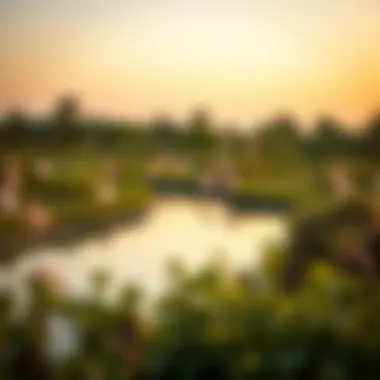
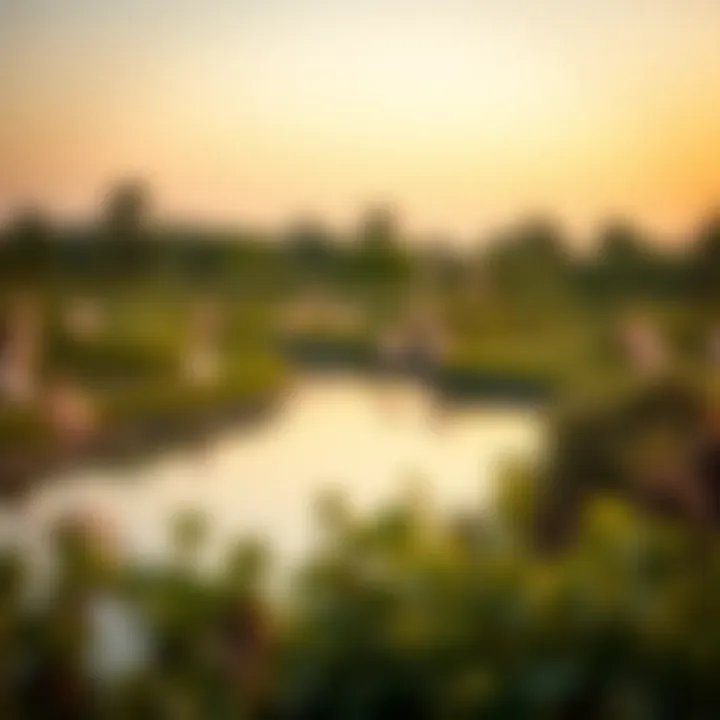
"Preserving nature is not an act of altruism; it is an investment in the future of our society."
Future of Ras Al Khor
The future of Ras Al Khor stands at a significant crossroads where the natural beauty of its wildlife sanctuary meets the relentless pace of urban development in Dubai. This intersection presents a unique opportunity for stakeholders, including investors and local communities, to shape how this ecologically rich area evolves over time. Balancing conservation with growth concerns is vital, as it aids in sustaining the sanctuary's delicate ecosystem while fostering economic development.
As the city continues to expand, the preservation of Ras Al Khor becomes even more critical. The wildlife sanctuary not only plays host to flamingos but also supports a variety of other species, providing an essential refuge in a rapidly urbanizing environment. Maintaining this ecological haven can lead to synergistic benefits where urban growth and biodiversity can thrive alongside one another. Here are some specific elements that illustrate why the future of Ras Al Khor is so significant:
- Biodiversity Conservation: Protecting wildlife and their habitats ensures a diverse ecosystem, which in turn supports overall environmental health.
- Tourism Growth: As Dubai positions itself as a leading travel destination, the sanctuary’s allure for eco-tourism can enhance its attractiveness to visitors, thus boosting local businesses.
- Urban Planning: Thoughtful integration of natural spaces into urban designs can lead to more livable cities, enhancing the quality of life for residents.
Development Plans
Dubai's growth trajectory includes several ambitious plans for infrastructure and development around Ras Al Khor. The vision incorporates modern design while aiming to preserve the sanctuary's ecological integrity. Specific development proposals focus on creating spaces that not just accommodate human needs but also enhance the habitat's value.
In recent years, there have been discussions surrounding the potential for eco-friendly tourist facilities, educational centers, and sustainable transport solutions that can link urban areas with the sanctuary. These plans are largely about providing access to the beauty of Ras Al Khor without encroaching on its natural landscape. By fostering responsible tourism, the sanctuary can remain a vibrant part of the urban narrative, attracting both domestic and international visitors. Some important aspects of the development plans include:
- Environmental assessments to gauge the effect on local wildlife.
- Collaborative projects between government entities and private sector stakeholders aimed at sustainable development.
- Community engagement initiatives to gather input and ensure the voices of local residents are considered in planning decisions.
Sustainable Growth Strategies
Sustainable growth strategies are paramount for maintaining the delicate balance between urban development and conservation at Ras Al Khor. Only through integrated approaches can Dubai ensure that this precious ecosystem does not merely survive but thrives amidst urban pressures. Such strategies often encompass innovative practices and policies designed to minimize ecological footprints while maximizing benefits for both the environment and human habitat.
Practically, these strategies might involve:
- Green Building Standards: Encouraging the construction of energy-efficient, eco-friendly buildings that blend into the surrounding natural environment.
- Water Conservation Initiatives: Implementing systems that reduce water usage and protect the vital waterways surrounding the sanctuary.
- Public Awareness Programs: Educating visitors and residents about the importance of biodiversity to foster a culture of conservation and respect for nature.
"It is essential that any future plans for Ras Al Khor reflect a deep respect for its unique ecology. With careful planning and consideration, urban development can complement rather than compromise the sanctity of this vital natural reserve."
In summary, as future developments unfold at Ras Al Khor, the critical theme centers on adaptability and coexistence. The challenge lies in harnessing the best insights and approaches that ensure not only the survival of its flamingos but also a responsible blueprint for urban growth. Investors and stakeholders have a unique opportunity to shape how the sanctuary fits within the broader urban landscape while preserving its essential ecological functions, ensuring that the future of Ras Al Khor is bright both for its wildlife and its residents.
For more detailed information, resources regarding UAE’s environmental policies can be found at *.gov and studies on urban ecology are available through britannica.com and en.wikipedia.org.
Finale: The Interplay of Nature and Urbanization
The Ras Al Khor Wildlife Sanctuary holds a unique position in the dialogue surrounding nature and urban development, particularly in the bustling metropolis of Dubai. This interplay is not just a tale of coexistence but represents a vital narrative that can shape the future of urban planning. As investors and homeowners increasingly recognize the value of proximity to natural habitats, rhis area provides a compelling case study.
One notable factor is the sanctuary's role in promoting biodiversity. The presence of flamingos and other wildlife serves as a natural attraction, drawing not just locals but also tourists. This influx can enhance property values, offering investors a dual opportunity: contribute to conservation efforts while capitalizing on the growing demand for eco-conscious living.
Moreover, Ras Al Khor exemplifies the balance that can be struck when urban migration meets environmental sustainability. With the low-rise structures adjacent to the wetlands, developers have a model demonstrating that development does not have to come at the cost of losing natural spaces.
For investors, understanding this dynamic is crucial. It creates the potential for unique real estate offerings that appeal to a demographic increasingly concerned about environmental impact. Properties that prioritize green spaces tend to cultivate community engagement, creating value beyond mere numbers on a balance sheet.
"A thriving environment enriches urban living; to ignore nature is to jeopardize progress."
In summary, the intricate relationship between the Ras Al Khor Flamingos and Dubai's urban landscape underscores the necessity for encompassing approaches in planning. Viewing urbanization through an ecological lens could yield benefits across sectors – real estate, tourism, and conservation alike, promoting a more sustainable version of life in this modern city.
Key Takeaways for Investors
- Proximity to Nature: Properties closer to Ras Al Khor may see increased demand as buyers increasingly prioritize access to green spaces.
- Biodiversity Equals Value: The presence of flamingos and other wildlife can enhance a property’s appeal, turning conservation areas into marketable assets.
- Sustainable Development: Investors should consider aligning with sustainability initiatives which not only provide ecological benefits but can also lead to long-term financial gains.
- Environmental Awareness: Growing consumer awareness and preference for eco-friendly options provide a ripe opportunity for those willing to invest in responsible developments.
Final Thoughts on Ras Al Khor
Ras Al Khor stands as a beacon for what modern urban life can aspire to be. The sanctuary serves not only a refuge for wildlife but also as a critical component in shaping how urban spaces respect and integrate nature. For investors and homebuyers alike, it's a reminder that the vibrancy of a city does not solely rest on its skyline or infrastructure. Instead, it is enhanced, even defined, by its connection to the natural world.
Investors interested in Ras Al Khor have a unique chance to actively participate in the nexus of conservation and urban planning, potentially reaping both financial rewards and a sense of contribution to environmental sustainability. As the city continues to evolve, embracing both nature and urban growth will be essential for creating a vibrant and lasting legacy.


